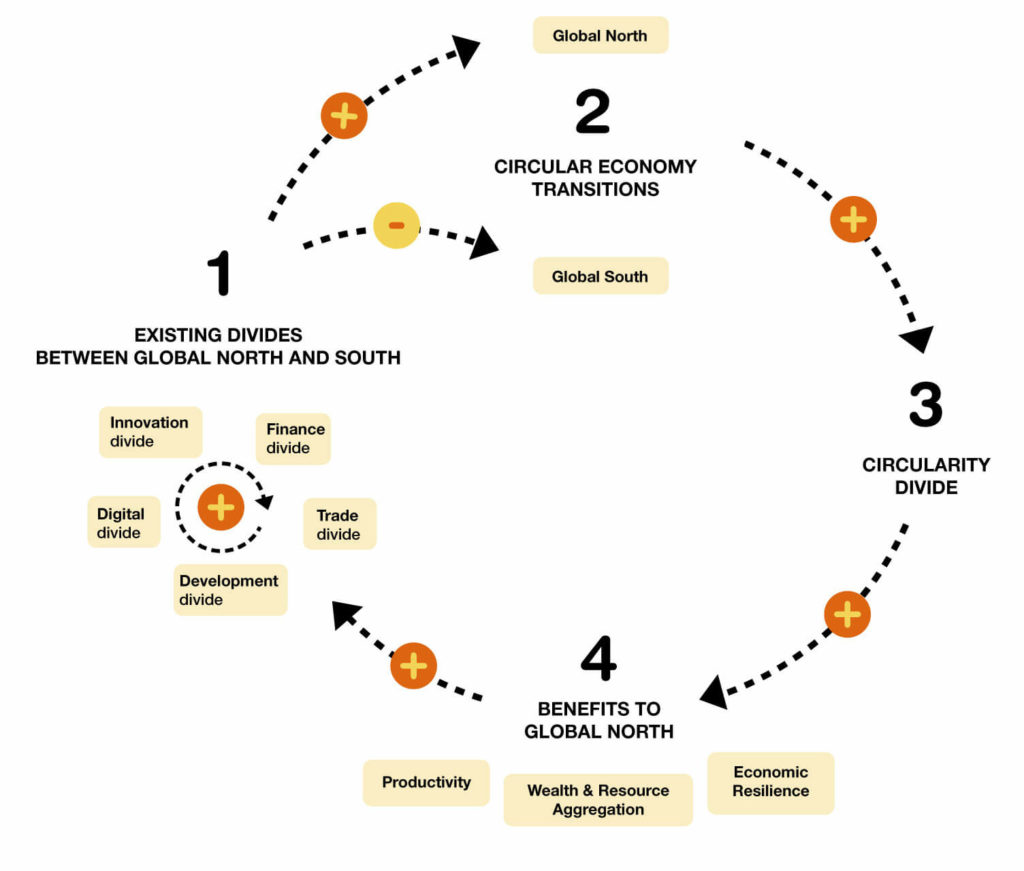Circularity for All?
Fragmented approaches to circular economy could exacerbate global inequities.
In a policy brief, “Addressing international impacts of the Dutch circular economy transition,” PBL Netherlands Environmental Assessment Agency calls for enhanced coherence and integration of policies related to circular economy, trade and development cooperation, more investments in knowledge and data on trade and impacts, as well as greater involvement of low- and middle-income countries in designing and implementing circular policies in general.
Such recommendations appear to address a phenomenon described by Chatham House researchers as the ‘circularity divide’ – that nations with a unilateral and fragmented approach to the circular economy will not only “fail to address domestic environmental problems” but, in turn, also create a divide that exacerbates global inequities. REVOLVE Circular spoke with Dr. Patrick Schröder and Dr. Jack Barrie from Chatham House to learn more about the circularity divide and what can be done to ensure circularity for all.
What is the circularity divide?
If nations transform their respective economies towards circularity in a competitive race, then “advanced industrialized nations hold a significant competitive advantage,” write the researchers from Chatham House, Saint Mary’s College of California, and De Montfort University. This advantage will increase as economic contests and systemic risks in the global economy intensify, and because developing countries are disadvantaged due to unequal power relations in value chains.
“Historical legacies and ongoing dynamics of unequal power structures determine the opportunities of different actors in an unequal world. These existing inequities will enable developed countries to transition to a circular economy more rapidly than less developed countries thereby creating a circularity divide,” explains the researchers’ joint paper ‘The circularity divide: What is it? And how do we avoid it?’
In turn, this divide will reinforce the structural inequities further. They observe that European nations, the United States, and China have already started adopting circularity as a domestic economic strategy due to supply chain volatility and the economic pressures brought about by COVID-19. The research has identified five already existing divides particularly relevant for a circular economy and circular transition:
- Digital divide: The significant inequity between the Global North and Global South in terms of access to digital equipment, skills to use digital technologies, and economic and social opportunities arising from new Industry 4.0 applications.
- Innovation divide: The capacity for innovation and industrial skill basis to design and produce advanced circular technologies and processes.
- Trade divide: Trade agreements from developed countries to secure the supply of critical raw and secondary materials to meet domestic demand, while pressuring developing countries to accept low-value and hazardous waste in return.
- Finance divide: Unequal access to circular economy-oriented finance to invest in technological and business model innovation, capacity building, and to develop the necessary skills base.
- Development divide: Developing countries must focus on immediate development challenges, such as basic necessities of life; therefore, enhancing participation and innovation for circularity are secondary concerns.
What led you to research the divisions related to a circular economy?
Dr. Barrie: This research is part of our general work on an inclusive circular economy and our specific interest in the role of trade flows. We initially conducted a systematic review of the literature discussing how international trade flows are linked to the circular economy. And we had a particular lens on how the changes in global trade flows as we move towards circularity will particularly impact developing countries. This research paper presents a rather simple mechanistic model to generate conversation around these divides, and how they interact with each other and in relation to the circular transition. The five divides are not an exhaustive list; they are just a handful of divides which are particularly relevant to the circular economy, while there are numerous other divides in play, and it’s a very complex issue.
How does the trade divide exacerbate global inequities?
Dr. Barrie: There is already a divide in terms of efficiency of trading transactions as well as an unequal value capture and quality of flows between the Global North and Global South. Already, developed industrialized countries hold a much more efficient trading capacity than developing countries – not just the trade infrastructure, the ports, the railways, and ways to move goods and ship goods, but also the digital systems that underpin these.
Overwhelmingly, 99% of circular trade is captured in the Global North, which tends to be the high-value trade flows. The trade flows going from the Global North to the Global South in terms of circular trade flows tend to be very low-value trade flows: these are, for instance, industrial wastes and residues, which are expensive to treat in a country with strong environmental regulations, but cheaper to treat in a country with poor environmental regulations.

Circular trade:
Any trade in physical goods or services that allow a country or company to undertake circular activities and that contributes to the transition towards a circular economy.
High value trade flows:
Trade of goods from which you can extract high circular value (e.g. scrap metals)
Low value trade flows:
Trade of goods with lower or non-circular value (e.g. oils, chemicals)
What are the implications of the finance divide and unequal access to circular-economy-oriented investments?
Dr. Schröder: The finance divide is a general gap that we also see in terms of climate finance. It is not just how governments invest in or spend on circular economy; the key challenge here is to attract private sector investment. And there is a clear gap of private sector investment in circular solutions in the least developed countries, also regarding infrastructure that would enable circular economy. We argue that circular economy finance is mostly going towards the countries which already have a certain level of industrialization, so it’s not necessarily looking at the link between poverty and waste.
How is the innovation divide connected with research and development?
Dr. Barrie: This divide refers to the ability of an individual country to generate innovations, which is generally determined by a national innovation system. This is a combination of institutions, government, academia, and research institutes that produce knowledge that the industry can use. There’s a significant innovation divide between developing and low-income countries and the advanced industrialized countries in the North. The bigger the already existing innovation gap becomes, the wider the gap for countries to transition to a circular economy. There are research institutes and universities in the Global South doing incredible work on this topic, but it is not being picked up enough, especially in Europe. There is a real need to connect research institutions across these borders to work together more collaboratively.

How does the development divide impact the circularity divide?
Dr. Schröder: The development divide goes down to the issues of how society is organized and how burdens and benefits are shared. For instance, how to significantly improve working conditions or living conditions, how to integrate the informal sector into value chains, and how do we do that in a meaningful way? Those are key questions to address if we want to make the circular economy work for human development objectives.
Dr. Barrie: The job aspect is critical, and it’s the link between the development divide and policy. There’s a real need now, as countries are being ambitious for their domestic policies, to link that to their trade agendas and the development agendas to make sure that the ramifications are dealt with fairly and inclusively.
How can the world address the circularity divide?
Dr. Schröder: We need to have a multilateral approach and come together to address a global challenge. Circular economy solutions can be integrated a lot more into multilateral development, corporate finance and investments by multilateral development banks. We see that companies and countries are looking at the circular economy, not only as a kind of European thing that they should do, but as an opportunity. They have realized that circularity is already happening in our societies, and this can potentially become a competitive advantage because we’re not locked into a linear system. It’s a mindset shift.
Dr. Barrie: We need to recognize that everything we do domestically in our circular transitions will impact others around the world to the global value chain restructuring. We need a global consciousness. A connected consciousness on what a circular transition is. Is it about domestic competitiveness and supply chain resilience? Or is it about meeting global development goals and a global and inclusive transition towards a better society? At the moment, a lot of policies are focusing on the former and we need to shift it to the latter. That’s the real key outcome of our research.